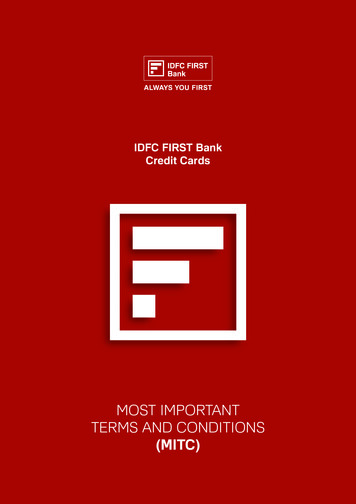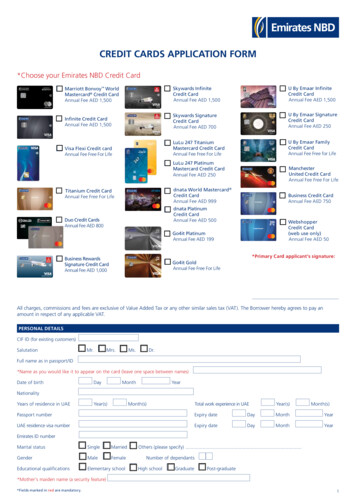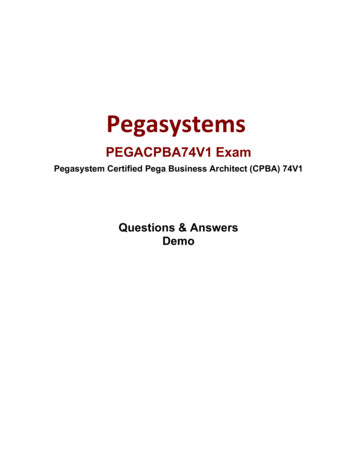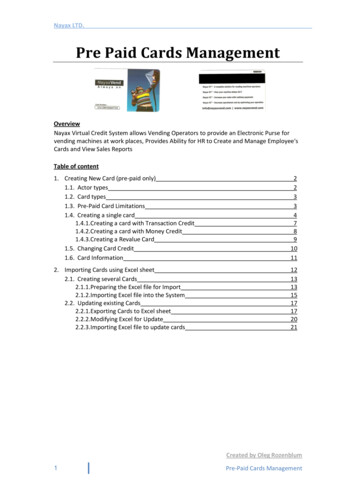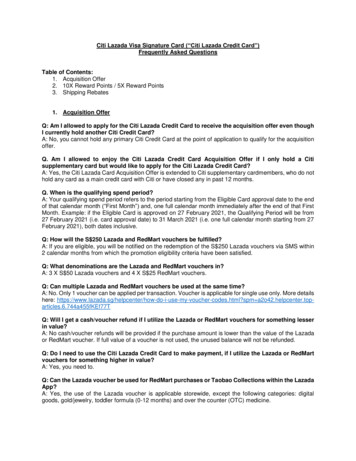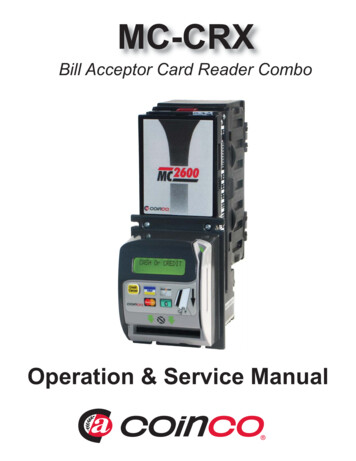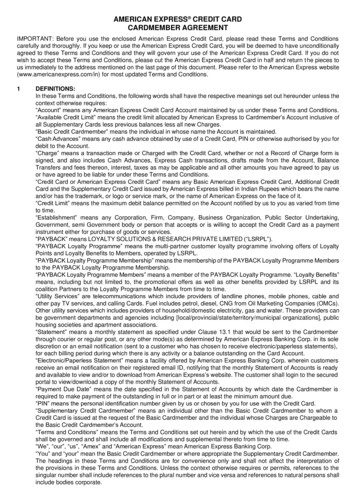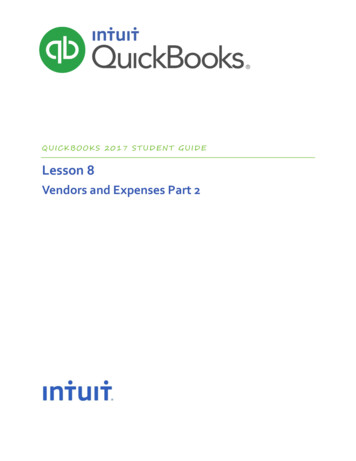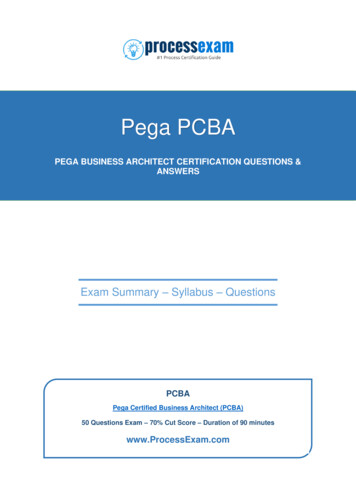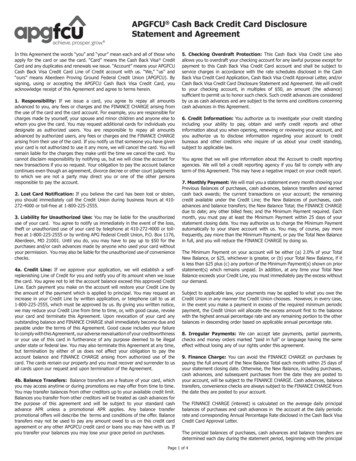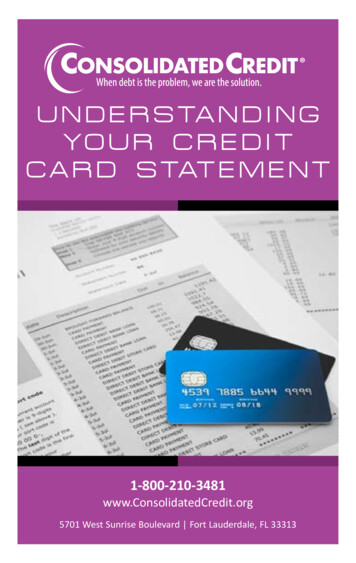
Transcription
U N D E R S TA N D I N GYO U R C R E D I TC A R D S TAT E M E N T1-800-210-3481www.ConsolidatedCredit.org5701 West Sunrise Boulevard Fort Lauderdale, FL 33313
Congratulations on taking this important step to manage yourcredit card debt more effectively. Consolidated Credit has beenhelping Americans across the country solve their debt andcredit problems for over 25 years.Our educational team has created over forty publications tohelp you improve your finances. Visit ConsolidatedCredit.orgto access all our publications free of charge. You’ll also find arange of financial education resources, including interactivecourses, instructional videos, webinars, infographics, and more.Our mission is to provide all the tools you need to becomedebt-free and use money wisely, so you can plan for the futureand build wealth.If you’re feeling overwhelmed by high-interest rate credit carddebt, I encourage you to call 1-800-210-3481 to receive a freeevaluation from a certified credit counselor. Together, you canfind the best solution to pay off your debt and achieve financialstability.I also invite you to share these resources with others youknow who want to improve their finances. ConsolidatedCredit provides partnership programs, which can help groups,businesses and communities learn and grow together. If you’reinterested in learning more, please call us and we’ll be happy tohelp you customize a program for your organization.Sincerely,Gary S. HermanPresidentConsolidated Credit
Understanding Your Credit CardStatementHow to read monthly statements as you manage your debtThese days with automation, going paperless, and apps thatbring up your balance with a click, it can be easy to forget toreview your monthly credit card statements. However, thesestatements can provide essential information about youraccounts that is important for you to monitor.Looking carefully at your credit card statements each monthcan help you discover information that would otherwise behidden. You can manage your balances more effectively andavoid problems with debt. This guide walks you through all theinformation your monthly statements contain and how you canuse it to your advantage.It’s important to note that no matter what type of credit cardyou have or who the credit card issuer is, all the informationoutlined below must be included in your statement.Page 1Payment InformationAt the top of the first page of your credit card statement, therewill be a section titled “Payment Information”It must show:1. The New Balance on your account2. The Minimum Payment Due for that month3. Your Payment Due Date, which will include a time thatonline and phone payments must be received by2
There will also be two warningsthat you need to pay attentionto: Late Payment Warning:This warning will providedetails on the late fee andpenalty APR that may beapplied to your account if you don’t pay by the due date Minimum Payment Warning: This warning explains thatonly making the minimum payment will increase the timeto payoff and cost of your debt. Below it, you will find atable that looks like this:YOU WILL PAYIF YOU MAKE NOOFF THE BALANCEADDITIONAL CHARGESSHOWN ON THISUSING THIS CARD ANDSTATEMENT INEACH MONTH YOU PAY.ABOUT.AND YOU WILLEND UP PAYINGAN ESTIMATEDTOTAL OF.Only the minimum paymentX months or years XXXX.XX XXX3 years XXXX.XXThe purpose of this table is to help you understand the timeand financial cost of minimum payments. The second linewill only be included if your balance would take more thanthree years to pay off with minimum payments. Then they willinclude the second line to show you how much you would saveby paying off your balance with fixed payments made overthree years.Finally, below this table, you will see a line that says, "If youwould like information about credit counseling services, call3
1-XXX-XXX-XXXX." This provides a toll-free number that youcan call to learn more about credit counseling—a service thatcan help you pay off high-interest rate credit card balances ifyou are having trouble paying them off on your own.Account SummaryThe second section that will appear on any credit cardstatement will be the account summary section. This sectiondetails how the credit card issuer arrived at the new balancelisted in the first section.For general-purpose credit cards, the summary will include: Previous balance Payment credits Purchases Cash advances Balance transfers Fees charged Interest charged New balance The opening and closing date for the billing cycle Past due amount Credit limit Available credit Cash advance limit Available credit for cash advances4
For specialized credit cards such as store cards and gas cards,not all this information may be included. For example, moststore cards will not offer cash advances or balance transfers.Review this section carefully. Here are some tips on what youwant to look for: Make sure the payment you made the previous month iscorrect Pay attention to how much you added in new purchases,as this may be a sign that you are overspending on credit Be aware that balance transfers and cash advances willhave a different interest rate applied to them, which ishigher and applies immediately See how much you’re adding in cost with interest chargesand fees Compare your new balance to the available credit to seehow much of your available credit you are using; this isknown as your credit utilization ratio and it can negativelyaffect your credit score if you are using more than 30% ofyour available credit limitReward DetailsFor any credit card that offers a reward program, you will alsosee a summary of your rewards on the first page of your creditcard statement. The information contained in this sectionwill vary depending on the type of rewards credit card. Forexample: 5A cash-back rewards card will include a summary of youravailable cash-back balance
Point rewards credit cards will include a summary of thepoints earned and how to redeem them Travel rewards credit cards may include a summary of themiles earned during that billing cycle Gas cards may list the number of fuel credits earnedAccount messages/notificationsThis section may contain important information aboutupcoming changes to your account. For example, if yourinterest rate is changing, the credit card issuer must notify you45 days before that change occurs. This information wouldappear in this section.If you have a credit card with an annual fee, this section willalso notify you when that fee is coming up.For months where you have no notifications, this section will beblank or may not appear at all.Payment slipThe bottom of the first page of your statement will providea payment slip that should be included if you plan to mail inyour payment. It is pre-addressed so you can easily mail yourpayment. You must write the amount enclosed on the paymentslip and it must match the amount on the check or moneyorder included.If you don’t mail in your payments, you do not need to doanything with this part of your statement.6
Page 2Information about your accountThe "back" of the first page of your credit card statement (orPage 2 if you're looking at your statement electronically) iswhere you will find all the fine print about your account.It will include information about: How payments and interest are calculated on your account How to avoid interest charges using your credit card’sgrace period How to make your payment What to do if you believe there is a mistake on yourstatement Your rights if you are dissatisfied with your credit cardpurchases What to do if you have acredit dispute or lost orstolen credit cardAs much of a drag as it canbe to read any fine print, payattention to what this sectionsays. It can be eye-opening.This information typically won't change, but it's worth yourtime to read it when you first open a new credit card.Specifically, pay attention to the grace period. This is theamount of time after the closing date of the billing cyclewhere you can pay off your balance to avoid interest charges.In most cases, if you pay off the balance in full by the creditcard due date, interest charges will not apply if you started7
the billing cycle with a zero balance.Also, note the daily balance method. This explains that afterinterest charges begin to apply to your balance, they willcompound daily. That means that every day you leave yourbalance unpaid, it’s costing you money.Change of address informationThe second page of your statement will also includeinformation on what to do if you move. If you get paper statements by mail, this will typically be achange of address slip that you must mail in If you have gone paperless and get your statementselectronically, it will include instructions for where tochange your address online or over the phone.Page 3Account transaction details/activityThe last page of your credit card statement will include a moredetailed record of the transaction and account activity. Theinformation will be broken up into five sections:1. Payment details, which may also include other accountcredits2. Transaction details, which will show the purchases madeduring that billing cycle3. Total fees charged, which should hopefully be zero in mostcases4. Total interest charged, which is broken into each type of8
interest that may be applied to the account:a. Interest on purchasesb. Interest on cash advancesc. Interest on other balances5. Year-to-date totals, which shows the total fees and interestpaid on the account for the current yearYou can use this section for a few things: Review the transaction history to make sure you recognizeall the purchases; if you don’t, it could be a sign that theaccount has been compromised Pay attention to the fees and interest you're paying touse the account since this will help you be more aware ofwhat the credit line costs youInterest charge calculationThe next section also provides important information aboutyour account. This section provides details on the interestrates for the account andthe balances subject to eachinterest rate. This section isessential to review becauseyou need to know what ratesyou're paying.You will see a table that lookssomething like this:9
BALANCETYPEBALANCEANNUALEXPIRATIONSUBJECT TO INTERESTPERCENTAGEDATEINTEREST rsDepending on the type of card, some of these fields may not beincluded. For example, store credit cards will likely only showthe purchase interest rate since these cards don’t typically haveother rates. The expiration date column may only be includedon general-purpose cards because specialty cards may not everoffer promotional rates that would expire after a certain date.In addition to the numeric rates, you may see letters next tothe annual percentage rates: (v) means that the rate is variable, meaning it may changeover time (f) would indicate a fixed rate for the rare credit cards thatoffer fixed rates (d) means that rate is subject to the daily balance method (a) means that the rate is subject to the average dailybalance methodThe account information section on page 2 of the statementwill explain the various methods that may be used wheninterest is applied.There are a few things you need to pay close attention to as10
you review this section each month:1. Make sure you see when promotional rates are going toexpire. If you are enjoying low interest or no interest for aperiod, you want to pay off as much debt as possible beforethe rate’s expiration date.2. Take note of the rates on each account you have. Thatway, you can be strategic about using your credit cards. Forinstance:a. If you will be making a big purchase that will take a fewmonths to pay off, you want to use the card that has thelowest APR on purchases.b. If one of your cards offers a promotional rate on balancetransfers, you may want to consider moving somebalances over from other high-interest cards.3. Before you do a cash advance, consider the cost. You willnotice that the annual percentage rate on a cash advancewill typically be much higher than the other interest rateson the card. Cash advances can be very costly, and this rateapplies immediately when you use a cash advance.Important cardholder information/newsSome statements will have one final section that contains anyadditional information that the credit card issuer thinks thecardholder should know. This may include:11 Instructions on how to go paperless, so you can stopreceiving paper statements in the mail and receive themelectronically via email instead. Updates on new rewards that may be offered. Forexample, if you have a rewards credit card where therewards adjust each quarter, you may find details on the
rewards for the next quarter. Details on reward balances. For instance, if the credit cardissuer wants to provide an overview of points earned on areward program. Extra services the card may offer, such as credit scoretracking or fraud protection services.Make sure to review these updates so you can take fulladvantage of your account and avoid any potential issues.12
About Consolidated CreditConsolidated Credit is a consumer oriented, public educationorganization. We are an industry leader in providing creditcounseling and debt management services throughout theUnited States.Our mission is to assist individuals and families end financialcrises and help them solve money management problemsthrough education, motivation, and professional counseling.We are dedicated to empowering consumers througheducational programs that will influence them to refrain fromoverspending and abusing credit cards, as well as to encouragethem to save and invest. We sponsor local free seminars thatare also available to any group or organization that requests oureducational services.Our professionally trained counselors have assisted thousandsof families across the United States. Regardless of whether yourfinancial problems are due to the purchase of a new home, birthof a child, major illness, or any other circumstance, we can help.Our organization is funded primarily through voluntarycontributions from participating creditors. Our programs aredesigned to save our clients money and liquidate debts at anexcellent rate.Consolidated Credit is a member of the Better Business Bureau,the National Association of Credit Union, United Way of BrowardCounty and Financial Counseling Association of America.13
Consolidated Credit, a nationally recognized organization, will provideyou with professional financial education, counseling and resources.In addition, you can benefit from customized Debt Management Programs,which incorporate a bill consolidation plan to help you regainyour financial freedom.Our Certified Financial Counselors can: R educe or even eliminateinterest rates! E liminate late chargesand over-limit fees. Consolidate debts into onelower payment. H elp you pay off debt faster. R ebuild your credit rating. S ave you thousands of dollars. G et you on a plan to be debt free!Call today, and take your first step toward financial freedom!1-800-210-3481or visit www.ConsolidatedCredit.org5701 West Sunrise Blvd., Fort Lauderdale, Florida 33313
There is help waiting for you now. Reduce or eliminate interest charges. Consolidate credit card bills into onelower monthly payment. Pay off your debt in half the time. Save thousands of dollars.R-0513201-800-210-34815701 West Sunrise Boulevard Fort Lauderdale, FL 33313www.ConsolidatedCredit.org Email: counselor@ConsolidatedCredit.org
affect your credit score if you are using more than 30% of your available credit limit Reward Details For any credit card that offers a reward program, you will also see a summary of your rewards on the first page of your credit card statement. The information contained in this section will vary depending on the type of rewards credit card. For
